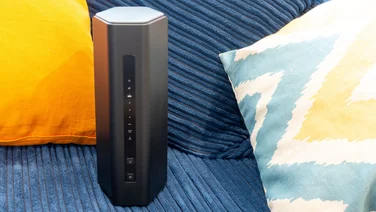To help us provide you with free impartial advice, we may earn a commission if you buy through links on our site. Learn more



- Fantastic performance and range
- Eight Ethernet ports
- Friendly, feature-packed interface
- The price, obviously
- Not much here for gamers
The Archer C5400X isn’t quite the most expensive router we’ve ever reviewed: that honour falls to the £400 Netgear R9000 Nighthawk X10. The C5400X is a similar proposition, though: it’s an uncompromising premium router, aimed at those willing to pay for exceptional performance. It’s marketed specifically as a gaming router, but it has a full set of features for regular home users.
TP-Link Archer C5400X review: What you need to know
The Archer C5400X is a tri-band MU-MIMO 802.11ac router with a theoretical bandwidth of 1Gbits/sec on the 2.4GHz band and 2,167Mbits/sec on each of its two 5GHz radios. Like most high-end routers, it doesn’t include a broadband modem – you have to connect your own to the dedicated Ethernet socket.
Although the C5400X is supposedly a gaming router, it doesn’t offer much in the way of specialist gaming capabilities. Rather, the point is speed. TP-Link’s marketing emphasises the C5400X’s 1.8GHz quad-core CPU, which should ensure that the router doesn’t succumb to lag, even under heavy load, and it also has eight chunky aerials to help provide a strong, fast Wi-Fi connection over long distances.
READ NEXT: The best wireless routers you can buy
TP-Link Archer C5400X review: Price and competition
The Archer C5400X isn’t cheap by any means, but it’s £50 less than the Netgear R9000 Nighthawk X10. It lacks that router’s 10Gbits/sec Ethernet connector, and it doesn’t have 802.11ad support either, but we doubt many people will miss those features.
If your priority is gaming features rather than raw performance, the obvious alternative is Netgear’s Nighthawk Pro Gaming XR500.
Wireless speeds aren’t quite as exceptional as they are on the C5400X but the XR500 has a peerless array of gaming-specific features, such as ping monitoring and geographic server filtering, and it’s a hundred quid cheaper.
TP-Link Archer C5400X review: Setup and features
You can set up the Archer C5400X via its web interface, or using TP-Link’s smartphone app for Android and iOS. I chose the latter, and found the process smooth and speedy. The app itself can be downloaded via a QR code that’s printed on both the box and the router itself, and this walks you through connecting your modem and configuring your Wi-Fi details.
From here on, the app becomes a basic management interface. You can use it to check who’s connected to your network, test your internet connection speed and tweak settings for your main and guest networks. By default, band steering is switched off, so the router’s three radios appear as three separate networks – the idea being that you can put your gaming devices on one 5GHz network and have everything else in your home connect to the other one, to minimise wireless contention. You can, of course, combine all three SSIDs into a single virtual network, if you prefer.
The app also gives you access to TP-Link’s distinctive HomeCare features. These include network-level antivirus features and parental controls, which can be used to block selected categories of website on individual devices, and restrict internet access to certain times of day. A one-touch QoS feature lets you choose whether gaming, streaming or other pursuits should be prioritised across the whole network.



For more advanced controls you’ll have to hop over to the web portal. This exposes TP-Link’s standard set of router controls and we’ve no complaints about that. It’s logically laid out, it’s very responsive, and it provides all the advanced options you’re likely to want, including DHCP server configuration and IP address reservation and port forwarding. There are a few nice surprises tucked away in the settings, too, including a built-in OpenVPN server and an Access Point mode, allowing you to partner the C5400X with an existing router.
The physical design is on point, too. The unit itself is quite low-key and comparatively compact (especially by the standards of most “gaming” devices), yet at the back you get a full eight Gigabit Ethernet ports – even the Nighthawk X10 only gives you six – of which two can be aggregated into a 2Gbits/sec connection; useful for hooking up NAS drives. At the front, three small buttons let you activate WPS, temporarily suspend the wireless network and disable the coloured LED on the router’s roof.
At the side, meanwhile, a pair of USB 3 ports enable you to connect both a printer and an external storage device. The latter can be used to share files and stream media and Mac users can alternatively use it as a backup destination for Time Machine. If you don’t want to fiddle with flash drives, there’s 16GB of storage built right into the router as well, which provides a handy way to quickly share files across your home network.
The only thing that’s notably absent is any gamer-specific customisations. As we’ve mentioned, TP-Link’s pitch to gamers isn’t about features; it’s entirely down to performance.



TP-Link Archer C5400X review: Performance
The Archer C5400X has an ambitious wireless specification, with a theoretical total throughput of 5,334Mbits/sec. I tested it in my usual way, connecting to the router from a laptop and copying a series of 100MB files from a wired NAS drive.
Initial results were very positive. With my laptop in the same room as the router, connected to one of the C5400X’s 5GHz radios, I saw download speeds of a superb 27MB/sec. That’s close to the fastest performance I’ve seen, and 1MB/sec higher than the Nighthawk X10 achieved.
Even more impressive was performance in other parts of the house. In the upstairs bedroom I still achieved fast download speeds of 15MB/sec and, when I moved to the bathroom at the back of my home – where regular routers often struggle to penetrate – the speed barely fell at all, giving me an excellent 14MB/sec downstream.
In short, the Archer C5400X was comfortably able to extend the full bandwidth of my 100Mbits/sec fibre broadband connection to the furthest ends of my home, something even multi-node mesh systems rarely manage.
Indeed, the results were so good, I was encouraged to test out the wireless connection on the terrace outside the rear of my house. This is usually a futile exercise, owing to the distance from the living room and the thickness of the outer wall but here, too, the C5400X had no problem at all. It delivered a rock-solid 6MB/sec download speed – more than enough to allow me to happily sit outside and work in the sunshine.
TP-Link Archer C5400X review: Verdict
TP-Link calls the Archer C5400X a gaming router, yet the one area where it’s conspicuously lacking is gamer-oriented features. Cynically, I find myself wondering whether TP-Link is trying to woo gamers simply because they tend to be less cost-averse than regular consumers.
Indeed, the marketing focus does the Archer C5400X an injustice, because this router is an outstanding all-rounder, with features and performance to satisfy the most demanding home user. The Netgear Nighthawk R9000 is a worthy rival, but the TP-Link’s extra Ethernet ports, nicer interface and lower price are likely to bring you more joy than the Nighthawk’s esoteric features.
If you’re looking for a lightning-fast, long-range wireless router – and if your budget will stretch to it – the TP-Link C5400X router deserves to be your first choice.







